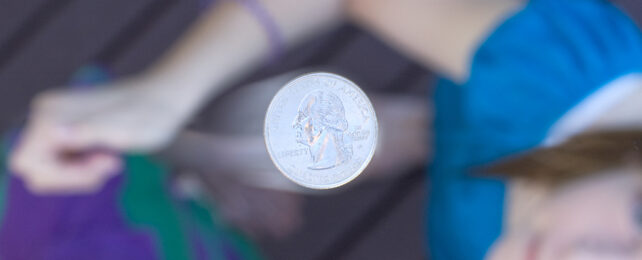We all know a coin toss has an even chance of coming up heads or tails, right? A new experiment shows that in certain situations, it's actually more likely to land on one side rather than the other.
The international team of researchers responsible for the experiment certainly put the work in, finding the average result of a total of 350,757 coin flips between them – a gigantic number that eclipses anything the authors had seen in coin toss academia.
An analysis of their results supports a theory from 2007 proposed by mathematician Persi Diaconis, stating the side facing up when you flip the coin is the side more likely to be facing up when it lands.
These latest experiments show that's the case 50.8 percent of the time. The bias seemed to apply across different coin types, but not across different individuals – so your own experience may vary.
"The standard model of coin flipping was extended by Persi Diaconis, who proposed that when people flip an ordinary coin, they introduce a small degree of 'precession' or wobble – a change in the direction of the axis of rotation throughout the coin's trajectory," the researchers write in their paper.
"According to the Diaconis model, precession causes the coin to spend more time in the air with the initial side facing up. Consequently, the coin has a higher chance of landing on the same side as it started."
That the results varied between researchers suggests that how the coin is tossed affects the chances of how it lands. Everybody has their own technique, catching the coin mid-flight or doing one last flip before looking. So the wobble in any individual's flipping action could have some bearing on the number of flips it manages to complete as well.
This is something that the team wants to look at in more detail in the future. The study authors also suggest that in betting and high-stakes decision-making, the alignment of the coin at the start should always be concealed. In coin tosses where the starting face was randomized, the researchers noticed an even split of heads and tails.
It's no small advantage, either. For instance, if someone bets a dollar on a coin toss hoping to take $2 on any win, they would make $19 on average for every 1,000 tosses. That's an advantage you don't even get in blackjack if you're playing with five other players and a dealer.
The fact this kind of bias has not been observed clearly in the past is astonishing. Coin flips have been used to determine monumental events since the time of the Romans. Even in the present day it's been used to decide the fate of political elections, soccer finals, and public policy decisions.
"Despite the widespread popularity of coin flipping, few people pause to reflect on the notion that the outcome of a coin flip is anything but random," write the researchers.
The research has yet to be published in a peer-reviewed journal, but is available to read online at arXiv.
